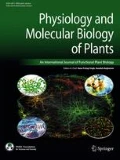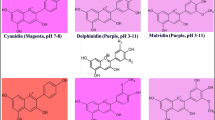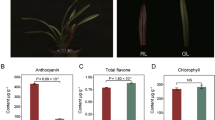Abstract
Coloration directly affects the commercial value of Schisandra chinensis fruits. The composition and content of anthocyanin determine the S. chinensis fruit coloration. However, the molecular mechanism of anthocyanin biosynthesis and regulation in this fruit remains unknown. In this study, we performed integrative full-length transcriptomics and targeted metabolomics analyses in S. chinensis fruits at four different developmental stages to elucidate the coloration mechanism. Cyanidin3-O-xyl-rutinoside is the key anthocyanin, which is responsible for the reddening of S. chinensis fruits, and its accumulation gradually accelerated from the 80th day after fluorescence. Overall, 122,289 unigenes with an average length of 2592 bp and an N50 of 4232 bp were obtained through single-molecule real-time sequencing; a total of 16,456 differentially expressed genes were identified. Moreover, 10 full-length structural genes related to anthocyanin biosynthesis were found to be significantly differentially expressed with fruit ripening. Moreover, 10 glycosyltransferases (GTs) that may possess the activities of anthocyanidin 3-O-glucosyltransferase, anthocyanidin 3-O-glucoside rhamnosyltransferase, and xylosyltransferases, which are involved in the final three steps for cyanidin3-O-xyl-rutinoside synthesis, were identified through phylogenetic analysis. Based on these findings, we constructed the complete anthocyanin biosynthetic pathway in S. chinensis fruits; five ScMYBs, three ScbHLHs, and two ScWD40s potentially involved in regulating anthocyanin biosynthesis in S. chinensis fruits were also selected. Our study provides the foundation for further research on the molecular mechanism of anthocyanin biosynthesis and regulation for improving the quality of S. chinensis fruits. The results of full-length transcriptomes would provide researchers with novel insights into the molecular cloning of enzymes and their activity.









Similar content being viewed by others
References
Alexander P, Wikman G (2008) Pharmacology of Schisandra chinensis Bail.: an overview of Russian research and uses in medicine. J Ethnopharmacol 118:183–212
Baudry A, Caboche M, Lepiniec L (2006) TT8 controls its own expression in a feedback regulation involving TTG1 and homologous MYB and bHLH factors, allowing a strong and cell-specific accumulation of flavonoids in Arabidopsis thaliana. Plant J 46:768–779
Brugliera F, Holton TA, Stevenson TW, Farcy E, Lu CY, Cornish EC (1994) Isolation and characterization of a cDNA clone corresponding to the Rt locus of Petunia hybrida. Plant J 5:81–92
Chen PN, Chu SC, Chiou HL, Kuo W-H, Chiang CL, Hsieh Y-S (2006) Mulberry anthocyanins, cyanidin 3-rutinoside and cyaniding 3-glucoside, exhibited an inhibitory effect on the migration and invasion of a human lung cancer cell line. Cancer Lett 235:248–259
Chinese Pharmacopoeia Commission (2015) Pharmacopoeia of the People’s Republic of China [S], vol 1. China Medical Science Press, Beijing
Chung M-Y, Shin EJ, Choi H-K, Kim SH, Sung MJ, Park JH, Hwang J-T (2017) Schisandra chinensis berry extract protects against steatosis by inhibiting histone acetylation in oleic acid–treated HepG2 cells and in the livers of diet-induced obese mice. Nutr Res 46:1–10
Cui GW, Chai H, Yin H, Yang M, Hu GF, Guo MY, Rugeletu Yi, Zhang P (2019) Full-length transcriptome sequencing reveals the low-temperature-tolerance mechanism of Medicago falcata roots. BMC Plant Biol 19:575–590
Editing Committee of Chinese Flora, Chinese Academy of Sciences (1996) Flora of China: Vol 30(1) [M]. Beijing: Science Press. p 252
European Pharmacopoeia 8.0, (2013) Schisandra fruit. European Directorate for the Quality of Medicines, France, Strasburg, pp. 1381
Hong M, Zhang Y, Li S, Tan HY, Wang N, Mu S, Hao X, Feng Y (2017) A network pharmacology-based study on the hepatoprotective effect of Fructus Schisandrae. Molecules 22:1617–1627
Jeong ST, Goto-Yamamoto N, Kobayashi S, Esaka A (2004) Effects of plant hormones and shading on the accumulation and the expression of anthocyanin biosynthetic genes in grape berry skins. Plant Sci 167:247–252
Jung S, Moon HI, Kim S, Quynh NTN, Yu J, Sandag Z, Thile DD, Lee H, Lee H, Lee MS (2019) Anticancer activity of gomisin J from Schisandra chinensis fruit. Oncol Rep 41:711–717
Karaaslan M, Yılmaz FM, Karaaslan A, Vardin H (2016) Synthesis and accumulation of anthocyanins in sour cherries during ripening in accordance with antioxidant capacity development and chalcone synthase expression. Eur Food Res Technol 242(2):189–198
Laura J (2013) New insights into the regulation of anthocyanin biosynthesis in fruits. Trends Plant Sci 18:477–478
Li Y, Dai C, Hu C, Liu Z, Kang C (2017) Global identification of alternative splicing via comparative analysis of SMRT- and Illumina-based RNA-seq in strawberry. Plant J 90:164–176
Li YZ, Ren S, Yan XT, Sun YS, Li HP, Li W, Liu YY, Wang Z (2018) Improvement of Cisplatin-induced renal dysfunction by Schisandra chinensis stems via anti-inflammation and anti-apoptosis effects. J Ethnopharmacol 217:228–237
Liao JJ, Zang J, Yuan F, Liu S, Zhang YB, Li HY, Piao ZY, Li HB (2016) Identification and analysis of anthocyanin components in fruit color variation in Schisandra chinensis. J Sci Food Agric 96:3213–3219
Liu YF, Liu J, Qi YW, Zhang AL, Liu ZD, Ren XL (2019) Identifcation and characterization of AcUFGT6b, a xylosyltransferase involved in anthocyanin modifcation in red-feshed kiwifruit (Actinidia chinensis). Plant Cell Tissue Organ Culture PCTOC 138:257–271
Liu YF, Ma KX, Qi YW, Lv GW, Ren XL, Liu ZD, Ma FW (2021) Transcriptional regulation of anthocyanin synthesis by MYB-bHLH-WDR Complexes in Kiwifruit (Actinidia chinensis). J Agric Food Chem 69:3677–3691
Livak KJ, Schmittgen TD (2001) Analysis of relative gene expression data using realtime quantitative PCR and the 2−ΔΔCT method. Methods 25:402–408
Morita Y, Hoshino A, Kikuchi Y, Okuhara H, Ono E, Tanaka Y, Fukui Y, Saito N, Nitasaka E, Noguchi H, Iida S (2005) Japanese morning glory dusky mutants displaying reddish-brown or purplish-gray fowers are defcient in a novel glycosylation enzyme for anthocyanin biosynthesis, UDP-glucose: anthocyanidin 3-O-glucoside-2″-O-glucosyltransferase, due to 4-bp insertions in the gene. Plant J 42(3):353–363
Peng M, Miao M, Wang T, Liu D (2018) Effect of Fructus schisandrae syrup on bronchial asthma mice model. Saudi J Biol Sci 25:1806–1811
Qi T, Song S, Ren Q et al (2011) The jasmonate-ZIM-domain proteinsinteract with the WD-repeat/bHLH/MYB complexes to regulate jasmonate-mediated anthocyanin accumulation and trichome initiation in Arabidopsis thaliana. Plant Cell 23:1795–1814
Qi Y, Cheng X, Jing H, Yan T, Xiao F, Wu B, Bi K, Jia Y (2019) Effect of Alpinia oxyphylla—Schisandra chinensis herb pair on inflammation and apoptosis in Alzheimer’s disease mice model. J Ethnopharmacol 237:28–38
Rao GD, Zhang JG, Liu XX, Yi L (2019) Identification of putative genes for polyphenol biosynthesis in olive fruits and leaves using full-length transcriptome sequencing. Food Chem 300:125246–125255
Song L, Cui S, Li T, Yang S, Wang Q, He K, Zheng Y, He C (2018) Antibacterial effects of Schisandra chinensis extract on Staphylococcus aureus and its application in food. J Food Saf 38:12503–12513
Sun D, Li Q, Li HB, Li YH, Piao ZY (2014) Quantitative analysis of six lignans in fruits with different colors of Schisandra chinensis by HPLC. Nat Prod Res 28:581–585
Szopa A, Ekiert R, Ekiert H (2017) Current knowledge of Schisandra chinensis (Turcz.) Baill. (Chinese magnolia vine) as a medicinal plant species: a review on the bioactive components, pharmacological properties, analytical and biotechnological studies. Phytochem. Rev. 16:195–218
Szopa A, Dziurka M, Warzecha A, Kubica P, Klimek-Szczykutowicz M, Ekiert H (2018) Targeted lignan profiling and anti-inflammatory properties of Schisandra rubriflora and Schisandra chinensis extracts. Molecules 23:3103
Tulio AZ, Reese RN, Wyzgoski FJ, Rinaldi PL, Fu R, Scheerens JC, Miller AR (2008) Cyanidin 3-Rutinoside and Cyanidin 3-Xylosylrutinoside as primary phenolic antioxidants in black raspberry. J Agric Food Chem 56:1880–1888
Upton, R. (Ed.), Santa Cruz, California. American Herbal Pharmacopoeia and Therapeutic Compendium, 1999. Schisandra berry, Schisandra chinensis analytical, quality control and therapeutic monograph. pp. 1–25.
Vogt T, Jones P (2000) Glycosyltransferases in plant natural product synthesis: characterization of a supergene family. Trends Plant Sci 5:380–386
Wang M, Bi W, Fan K, Li T, Yan T, Xiao F, He B, Bi K, Jia Y (2018a) Ameliorating effect of Alpinia oxyphylla—Schisandra chinensis herb pair on cognitive impairment in a mouse model of Alzheimer’s disease. Biomed Pharmacother 97:128–135
Wang X, Yu J, Li W, Wang C, Li H, Ju W, Chen J, Sun J (2018b) Characteristics and antioxidant activity of lignans in Schisandra chinensis and Schisandra sphenanthera from different locations. Chem Biodivers 15:1800030–18000442
Wang YY, Zhang XD, Zhao YR, Yang J, He YY, Li GC, Ma WR, Huang XL, Su J (2020) Transcription factor PyHY5 binds to the promoters of PyWD40 and PyMYB10 and regulates its expression in red pear ‘Yunhongli No. 1.’ Plant Physiol Biochem 154:665–674
Wu XX, Zhang SM, Liu XH, Shang J, Zhang AD, Zhu ZW, Zha DS (2020) Chalcone synthase (CHS) family members analysis from eggplant (Solanum melongena L.) in the flavonoid biosynthetic pathway and expression patterns in response to heat stress. PLoS ONE 15:0226537–0226554
Xu W, Dubos C, Lepiniec L (2015a) Transcriptional control of flavonoid biosynthesis by MYB–bHLH–WDR complexes. Trends Plant Sci 20:176–185
Xu Z, Peters RJ, Weirather JL, Luo H, Liao B, Zhang X, Zhu Y, Ji A, Zhang B, Hu S, Au KF, Chen S (2015b) Full-length transcriptome sequences and splice variants obtained by a combination of sequencing platforms applied to different root tissues of Salvia miltiorrhiza and tanshinone biosynthesis. Plant J 82:951–961
You YL, Liang C, Han X, Guo JL, Ren CL, Liu GJ, Huang WD, Zhan JC (2017) Mulberry anthocyanins, cyanidin 3-glucoside and cyanidin 3-rutinoside, increase the quantity of mitochondria during brown adipogenesis. J Funct Foods 36:348–356
Yuan R, Tao X, Liang S, Pan Y, He L, Sun J, Ju W, Li X, Chen J, Wang C (2018) Protective effect of acidic polysaccharide from Schisandra chinensis on acute ethanol-induced liver injury through reducing CYP2E1-dependent oxidative stress. Biomed Pharmacother 99:537–542
Zeng TR, Zhang DF, Li YX, Li CH, Liu XY, Shi YS, Song YC, Li Y, Wang TY (2020) Identification of genomic insertion and flanking sequences of the transgenic droughttolerant maize line “SbSNAC1-382” using the single-molecule real-time (SMRT) sequencing method. PLoS ONE 15:226455–226474
Zhai J, Zhang F, Gao S, Chen L, Feng G, Yin J, Chen W (2018) Schisandra chinensis extract decreases chloroacetaldehyde production in rats and attenuates cyclophosphamide toxicity in liver, kidney and brain. J Ethnopharmacol 210:223–231
Zhang QT, Fan ST, Yang YM, Xu PL, Ai J (2016) De novo transcriptome assembly of Schisandra chinensis Turcz. (Baill.). Genomics Data 10:153–154
Zhang Q, Wang LL, Liu ZG, Zhao ZH, Zhao J, Wang ZT, Zhou GF, Liu P, Liu MJ (2020) Transcriptome and metabolome profiling unveil the mechanisms of Ziziphus jujuba Mill. peel coloration. Food Chem 312:125903–125909
Zhu L, Li B, Liu X, Huang G, Meng X (2015) Purification of six lignans from the stems of Schisandra chinensis by using high-speed counter-current chromatography combined with preparative high-performance liquid chromatography. Food Chem 186:146–152
Funding
In this work, Haiyan Li proposed the experimental design, evaluated data, and wrote the manuscript. Hongbo Li funded acquisition, administrated and supervised the project, and participated in the experiment. Chunxue Fan performed a quantitative analysis of anthocyanins. Jiushi Liu and Biao Wang corrected the manuscript. All authors read and approved the final manuscript.
Author information
Authors and Affiliations
Corresponding author
Ethics declarations
Conflict of interest
The authors declare that they have no known competing financial interests or personal relationships that could have appeared to influence the work reported in this paper.
Additional information
Publisher's Note
Springer Nature remains neutral with regard to jurisdictional claims in published maps and institutional affiliations.
Supplementary Information
Below is the link to the electronic supplementary material.
Rights and permissions
About this article
Cite this article
Li, H., Fan, C., Liu, J. et al. Integration of full-length transcriptomes and anthocyanin metabolite analysis for understanding fruit coloration mechanism in Schisandra chinensis. Physiol Mol Biol Plants 28, 921–933 (2022). https://doi.org/10.1007/s12298-022-01179-3
Received:
Revised:
Accepted:
Published:
Issue Date:
DOI: https://doi.org/10.1007/s12298-022-01179-3




